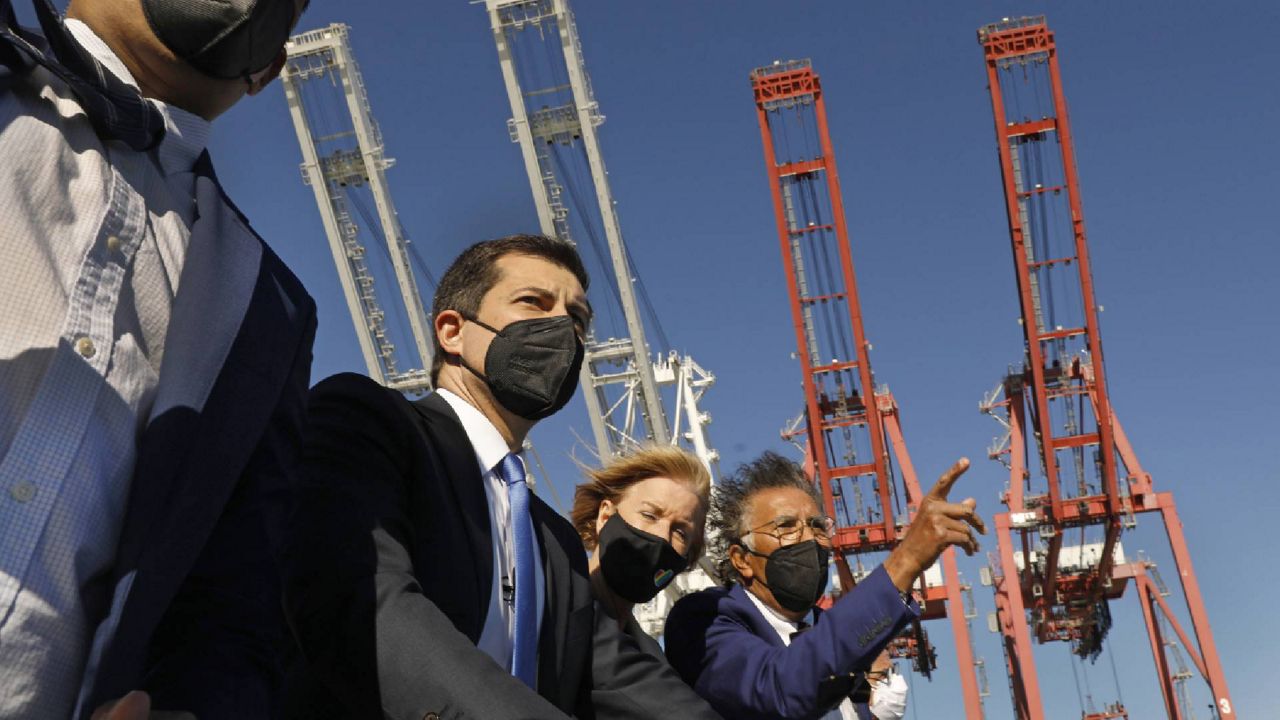Major U.S. ports and Biden administration officials are still working to drive down a historic backlog of goods affecting the country’s supply chain, even as port actions and a partnership forged with the federal government have abated some congestion in the last few months.
But in the short-term, federal solutions are limited, experts say, as the COVID-19 pandemic has both caused the buildup by surging consumer demand and also revealed cracks in how supply chain infrastructure functions at peak levels.
“These supply chains are really gummed up right now, and it's going to take quite a while for us to figure out how to get them all back going,” said Rob Handfield, a supply chain expert and distinguished professor at North Carolina State University.
“It'll probably be late 2022 before that happens," he added.
The need for long-term fixes to port infrastructure — such as the increased use of railways and an effort to digitize operations — is the “underlying reality” of supply chain pressures, said the White House’s point person for ports on Thursday.
Still, the last two-and-a-half months have marked progress, evidenced in part by a near 40% drop in the number of long-dwelling import containers sitting on docks at the Los Angeles and Long Beach ports since Nov. 1, the busiest container ports in the U.S.
That decline in containers is closer to 59% for the LA port as of Tuesday’s data, according to spokesperson Phillip Sanfield.
“In a word, I would say there’s been improvement,” he told Spectrum News. “I mean, 50% reduction is nothing to sneeze at.”
Sanfield said the challenge remains an “unprecedented American consumer buying surge” which began with the pandemic and “largely has not let up.”
The Biden administration launched a supply chain task force in June and appointed a port envoy, John Porcari, in late August to represent the White House in supply chain efforts.
Sanfield said the ports speak to Porcari “literally daily,” either in person or over the phone.
Speaking from the White House last week, Porcari admitted it’s unclear whether the worst is over.
“It’s hard to tell whether the supply chain pressures have peaked,” he told reporters. “We clearly have changes to make to build a more durable, resilient supply chain.”
The reality is that there is only so much the federal government can do in the short-term to fix the issues, explained Handfield, who has also served as an adviser to the White House task force.
“So in the short term, we're going to see shortages. We're going to see prices go up because of supply. And we're just going to have to live with that,” he said. “It’s not good news.”
One of the most effective actions has been the ports’ threat to impose fees on shipping containers that sit for too long, starting with a $100 fee and increasing it by $100 each additional day. But just the threat of the fine caused shipping companies to start moving their containers, and the fee has now been postponed several times.
And another new fee announced at the end of 2021 — one for empty containers — might not be needed either, though it’s slated to go into effect Jan. 30.
“In the same way, we were starting to see empty containers move off of our docks as well,” Sanfield said. “That announcement prompted a lot of discussion, and we tentatively have taken it off of our voting consideration.”
But some of the most critical improvements to ports will take time, including a shift to digital operations and an expansion of the use of trains to transport goods away from docks.
Transportation Secretary Pete Buttigieg on Tuesday visited the California ports, highlighting a recent $52 million federal grant for a new rail support facility at Long Beach.
“Everything goes better when states and local leaders and the federal government are working together,” he said in a press conference. “I cannot wait to put to work the funds from that $17 billion being committed to ports, thanks to that Bipartisan Infrastructure Law.”
Meanwhile, Buttigieg and the Biden administration have used the flow of goods around the Christmas holiday as evidence that short-term supply chain improvements are working. The White House pointed to data showing that holiday sales rose 8.5% from 2020 to 2021 and that the vast majority of packages arrived “on time or with minimal delays.”
“The much-predicted crisis didn’t occur,” said President Biden at a meeting with the supply chain task force in late December.
But local and port officials on Tuesday repeatedly called the backlog a “crisis,” however solvable.
“When you think there's a crisis, this is an opportunity. Because our ports have been lacking in the infrastructure,” said Willie Adams, president of the International Longshore and Warehouse Union. “We have to put our issues in place.”



